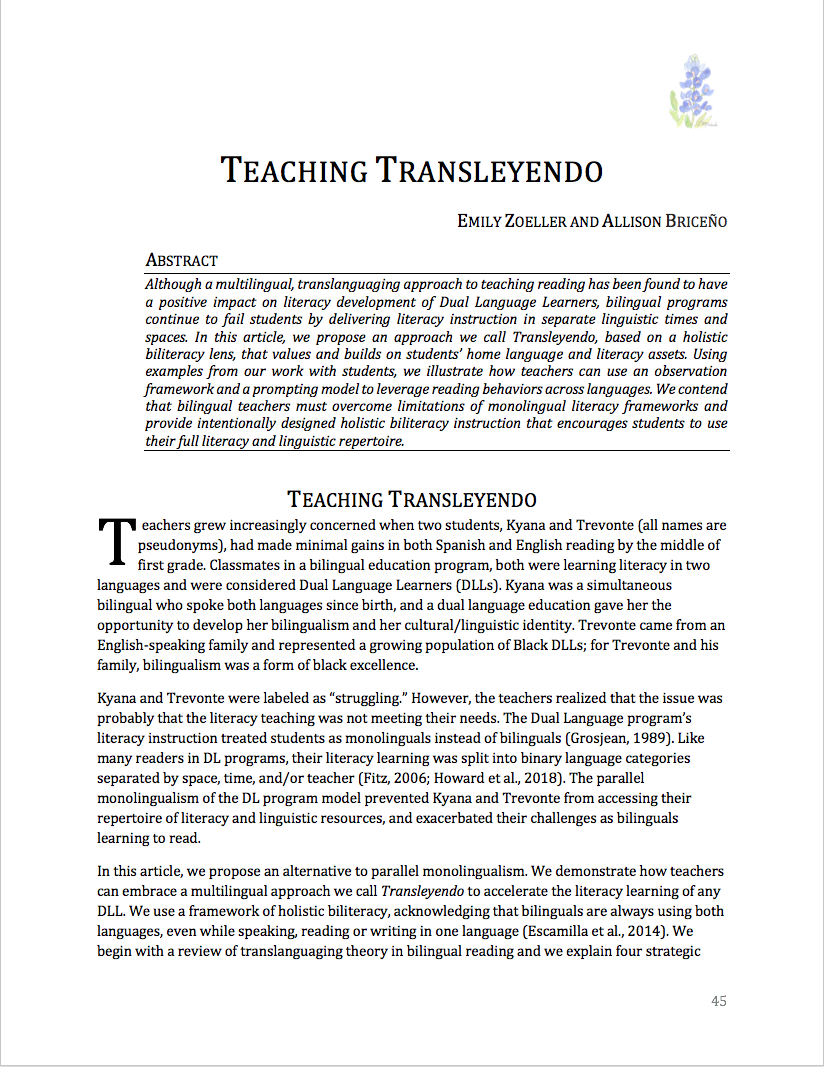Teaching Transleyendo
Keywords:
bliteracy, dual language, translanguaging, emergent literacy, bilingual, interventionAbstract
Although a multilingual, translanguaging approach to teaching reading has been found to have a positive impact on literacy development of Dual Language Learners, bilingual programs continue to fail students by delivering literacy instruction in separate linguistic times and spaces. In this article, we propose an approach we call Transleyendo, based on a holistic biliteracy lens, that values and builds on students’ home language and literacy assets. Using examples from our work with students, we illustrate how teachers can use an observation framework and a prompting model to leverage reading behaviors across languages. We contend that bilingual teachers must overcome limitations of monolingual literacy frameworks and provide intentionally designed holistic biliteracy instruction that encourages students to use their full literacy and linguistic repertoire.
References
Alvarez, L. (2012). Reconsidering academic language in practice: The demands of Spanish expository reading and students’ bilingual resources. Bilingual Research Journal, 35(1), 32–52. doi: 10.1080/15235882.2012.667373
Ascenzi-Moreno, L. (2018). Translanguaging and responsive assessment adaptations: Emergent Bilingual readers through the lens of possibility. Language Arts, 95(6), 355-369.
Ascenzi-Moreno, L., & Quiñones, R. (2020). Bringing Bilingualism to the Center of Guided Reading Instruction. The Reading Teacher, 74(2), 137-146.
Briceño, A. (2021). Influence of sequential and simultaneous bilingualism on second grade Dual Language students’ use of syntax in reading. Reading Psychology, 42(2), 150-176. DOI: 10.1080/02702711.2021.1888345
Briceño, A. & Klein, A. F. (2018). A second lens on formative reading assessment with multilingual students. Reading Teacher, 72(5), 611-621. DOI: 10.1002/trtr.1774
Bauer, E. B., Colomer, S. E., & Wiemelt, J. (2020). Biliteracy of African American and Latinx Kindergarten students in a dual-language program: Understanding students’ translanguaging practices across informal assessments. Urban Education, 55(3), 331-361.
Butvilofsky, S. A., Escamilla, K., Gumina, D., & Silva Diaz, E. (2021). Beyond Monolingual Reading Assessments for Emerging Bilingual Learners: Expanding the Understanding of Biliteracy Assessment Through Writing. Reading Research Quarterly, 56(1), 53-70.
Clay, M. M. (1991). Becoming Literate: The Construction of Inner Control. Heineman.
Clay, M. M. (2001). Change over time in children’s literacy development. Portsmouth, NH: Heinemann.
Clay, M. M. (2019). An observation survey of early literacy achievement. Portsmouth, NH: Heinemann.
Croce, K. A. (2017). Navigating assessment with linguistically diverse learners. Charlotte, NC: Information Age.
Domke, L. M. & Cárdenas Curiel, L. (2020). There’s no one way to be bilingual: Knowing students’ language practices. The Reading Teacher, early online version. doi:10.1002/trtr.196
Doyle, M. A. (2013). Marie M. Clay’s theoretical perspective: A literacy processing theory. In. D. E. Alvermann & R. B. Ruddell (Eds.), Theoretical models and processes of reading 6th ed. (pp. 636–656). International Reading Association.
Escamilla, K., Hopewell, S., Butvilofsky, S., Sparrow, W., Soltero-González, L., Ruiz-Figueroa, O. & Escamilla, M. (2014). Biliteracy from the start: Literacy Squared in action. Philadelphia, PA: Caslon Publishing.
Fountas, I. & Pinnell, G.S. (2016). The Fountas & Pinnell Literacy Continuum, Expanded Edition: A Tool for Assessment, Planning, and Teaching, PreK-8. Heineman.
García, O. (2020). Translanguaging and Latinx Bilingual Readers. The Reading Teacher, 73(5), 557-562.
García, G. E. & Godina, H. (2017). A window into bilingual reading: The bilingual reading practices of fourth-grade, Mexican American children who are Emergent Bilinguals. Journal of Literacy Research, 49(2), 273-301. doi: 10.177/1086296X1703727
García, O., & Kleifgen, J. A. (2020). Translanguaging and literacies. Reading Research Quarterly, 55(4), 553-571.
García, O. & Wei, L. (2014). Translanguaging: Language, bilingualism and education. New York, NY: Palgrave Macmillan.
Grosjean, F. (1989). Neurolinguists, beware! The bilingual is not two monolinguals in one person. Brain and language, 36(1), 3-15.
Hopewell, S. (2013). Strengthening bi-literacy through translanguaging pedagogies. Literacy Research Association Yearbook, (62), 234–247.
Hopewell, S. (2011). Leveraging bilingualism to accelerate English reading comprehension. International Journal of Bilingual Education and Bilingualism, 14(5), 603-620.
Howard, E. R., Lindholm-Leary, K. J., Rogers, D., Olague, N., Medina, J., Kennedy, B., Christian, D. (2018). Guiding principles for dual language education (3rd ed.). Center for Applied Linguistics.
Jiménez, R., García, G., & Pearson, D. P. (1995). Three children, two languages, and strategic reading: Case studies in bilingual/monolingual reading. American Educational Research Journal, 32(1), 67–97.
Jiménez, R., García, G., & Pearson, D. P. (1996). The reading strategies of Latina/o students who are successful English readers: Opportunities and obstacles. Reading Research Quarterly, 31(1), 90–112.
Kabuto, B. (2017). A socio-psycholinguistic perspective on biliteracy: The use of miscue analysis as a culturally relevant assessment tool. Reading Horizons, 56(1), 25-44.
López-Velásquez, A. M. & García, G. E. (2017). The bilingual reading practices and performance of two Hispanic first graders. Bilingual Research Journal, 40(3), 246-261. Doi: 10.1080/15235882.2017.1351008
Lyster, R. & Tedick, D. J. (2014). Research perspectives on immersion pedagogy: Looking back and looking forward. Journal of Immersion and Content-Based Language Education, 2(2), 210-224. doi:10.1075/jicb.2.2.04lys
Martínez-Roldán, C. M., & Sayer, P. (2006). Reading through linguistic borderlands: Latino students’ transactions with narrative texts. Journal of Early Childhood Literacy, 6(3), 293-322.
Poza, L. E. (2018). The language of ciencia: Translanguaging and learning in a bilingual science classroom. International Journal of Bilingual Education and Bilingualism, 21(1), 1-19.
Wurr, A. J., Theurer, J. L., & Kim, K. J. (2008). Retrospective miscue analysis with proficient adult ESL readers. Journal of Adolescent & Adult Literacy, 52(4), 324-333.
Zoeller, E. (2021). Antiracist teaching of multilingual readers. Manuscript submitted for publication.

Downloads
Published
Issue
Section
License
All copyright remains with the author.

